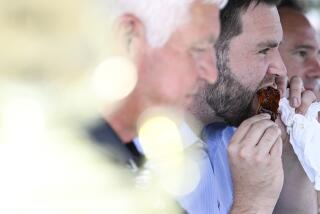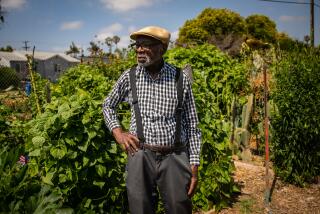White House veggie trail
- Share via
WASHINGTON — This year, the vegetables served at the White House will be as locally grown as possible -- some right on the South Lawn.
After a campaign by gardeners and sustainable-food activists, the first family has decided to dig up part of the White House grounds for a vegetable garden. In a ceremony today, First Lady Michelle Obama and local elementary students will break ground for the project.
It is part of the first lady’s promotion of healthful food for her daughters, Malia and Sasha, as well as for the nation. But like many parents, the Obamas have had mixed results: Michelle Obama recently said a version of “creamless” creamed spinach by White House executive chef Cristeta Comerford still was a bit too “green” for the kids.
More than 100,000 people have lobbied the president online to plant a garden on the White House lawn, according to Kitchen Gardeners International, a coalition of gardeners whose mission is to inspire and teach people to grow their own food. The group’s Eat the View campaign to plant “high-impact gardens in high-profile places” urged the first family to start an edible garden within the first 100 days of the Obama administration.
Launched in February 2008 and spearheaded by Roger Doiron, a gardener in Scarborough, Maine, the movement hoped to have the president’s family set the right example in terms of healthful eating -- “gardening for the greater good,” as Doiron said.
“It begins at home,” Doiron said. “That’s where we start. And if we get a number of people together carrying out these small actions, it will speak volumes and add up.”
Since the early 1990s, food-activist pioneers such as Berkeley restaurateur Alice Waters and author Michael Pollan have lobbied for an “edible landscape” across the 16 acres of White House grounds.
Though the Clintons did have a small rooftop garden that grew vegetables and herbs and Laura Bush made sure organic foods were served in the residence, this is the first full-scale planting on the lawn in more than 60 years -- since Eleanor Roosevelt had a victory garden during World War II.
“I’m just so gratified that this idea that seemed as right as rain from the beginning” has finally taken hold, said Waters, owner of the renowned Chez Panisse.
“Food is precious. It comes from the land,” she added. “And we have to take care of the land in order to nourish ourselves. It’s very hard to talk about food without talking about the garden.”
From a chilly corner of Maine, Doiron’s plot yielded $2,100 worth of produce from 35 different crops last year, he reported.
The message is that even in these difficult economic times, when families are struggling financially and psychologically, there are creative ways to put healthful food on the table, he said.
“Even if families can start with something small this season, they’re going to come away feeling empowered,” Doiron said. “There are things that we can do, even though we feel like we are up against incredible odds.”
Waters said she was especially pleased that at the White House garden’s groundbreaking, Michelle Obama would be surrounded by children.
As a founder of the Edible Schoolyard, a program in Berkeley and New Orleans to integrate organic gardens into schools, Waters wants all children to learn that vegetables and fruit come from the ground, not a store.
“If we make a beautiful place that children can walk through on tours of the White House, we can broadcast that message around the world,” Waters said. “It’s such a beautiful picture. It’s confirming and affirming their interest in the garden.”
--
More to Read
Sign up for Essential California
The most important California stories and recommendations in your inbox every morning.
You may occasionally receive promotional content from the Los Angeles Times.










